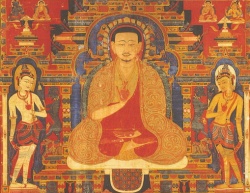Bardo - antarābhava
Bardo (Tib. བར་དོ་, Wyl. bar do; Skt. antarābhava) — commonly used to denote the intermediate state between death and rebirth, but in reality bardos are occurring continuously, throughout both life and death, and are junctures at which the possibility of liberation, or enlightenment, is heightened. Literal Meaning
Sogyal Rinpoche writes:
Bardo is a Tibetan word that simply means a “transition” or a gap between the completion of one situation and the onset of another. Bar means “in between,” and do means “suspended” or “thrown.”
Divisions
The different bardos can be categorized into four or six:
The Four Bardos
Literal Meaning
Sogyal Rinpoche writes:
Bardo is a Tibetan word that simply means a “transition” or a gap between the completion of one situation and the onset of another. Bar means “in between,” and do means “suspended” or “thrown.”
Divisions
The different bardos can be categorized into four or six:
the natural bardo of this life (Skt. jatyantarābhava; Tib. རང་བཞིན་སྐྱེ་བའི་བར་དོ་; Wyl. rang bzhin skye ba'i bar do) which begins when a connection with a new birth is first made and continues until the conditions that will certainly lead to death become manifest.
the painful bardo of dying (Skt. mumūrṣāntarābhava; Tib. འཆི་ཁ་གནད་གཅོད་ཀྱི་བར་དོ་; Wyl. 'chi kha gnad gcod kyi bar do) which begins when these conditions manifest and continues until the 'inner respiration' ceases and the luminosity of the dharmakaya dawns.
the luminous bardo of dharmata (Skt. dharmatāntarābhava; Tib. ཆོས་ཉིད་འོད་གསལ་གྱི་བར་དོ་; Wyl. chos nyid 'od gsal gyi bar do) which lasts from the moment the dharmakaya luminosity dawns after death and continues until the visions of precious spontaneous perfection are complete.
the karmic bardo of becoming (Skt. bhāvāntarābhava; Tib. སྲིད་པ་ལས་ཀྱི་བར་དོ་; Wyl. srid pa las kyi bar do) which lasts from the moment the bardo body is created and continues until the connection with a new rebirth is made.
The Six Bardos
The four above with the addition of:
5. the bardo of meditation (Skt. samādhyantarābhava; Tib. བསམ་གཏན་གྱི་བར་དོ་, Wyl. bsam gtan gyi bar do)
6. the bardo of dreaming (Skt. svapanāntarābhava; Tib. རྨི་ལམ་གྱི་བར་དོ་, Wyl. rmi lam gyi bar do)
These two bardos are part of the natural bardo of this life.
Literature
Dzogchen Tantras
Union of the Sun and Moon (Tib. ཉི་ཟླ་ཁ་སྦྱོར་, Wyl. nyi zla kha sbyor)
Self-arising Primordial Awareness (Tib. རིག་པ་རང་ཤར་, Wyl. rig pa rang shar)
Termas
Karma Lingpa, The Peaceful and Wrathful Deities, The Profound Dharma of Self-liberated Wisdom Mind (Tib. Zabchö Shitro Gongpa Rangdrol; Wyl. zab chos zhi khro dgongs pa rang grol), which contains the Great Liberation through Hearing in the Bardo (Tib. Bardo Tödrol Chenmo; Wyl. bar do thos grol chen mo) (see English translations in related article)
Instruction Manuals
Jikmé Lingpa, Yeshe Lama
Commentaries
Tsele Natsok Rangdrol, བར་དོ་སྤྱིའི་དོན་ཐམས་ཅད་གསལ་བར་བྱེད་པ་དྲན་པའི་མེ་ལོང་, bar do spyi'i don thams cad gsal bar byed pa dran pa'i me long (see English translation below)
Alternative Translations of the Term 'Bardo'
transitional process (Wallace)
Teachings Given to the Rigpa Sangha
For Sogyal Rinpoche's teachings on the bardos, see each of the individual articles on the four bardos.
For Garchen Rinpoche's teachings, see Six bardos

